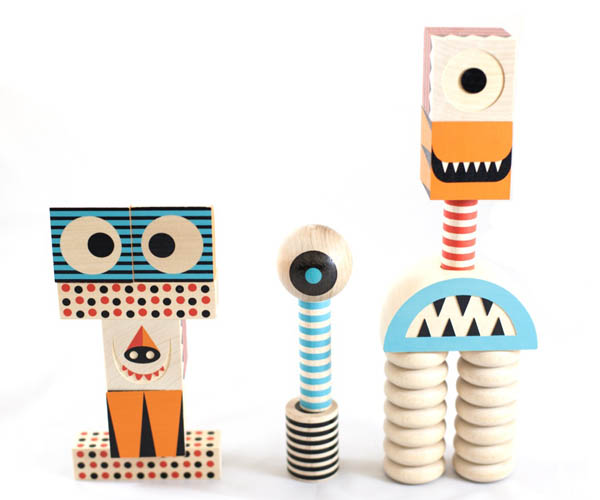In conjunction with Made in the USA, we’re celebrating contemporary American ingenuity by highlighting some of our favorite American artisans featured in the museum shop. Today we interview Pete Bultman of Uncle Goose, the world’s premier manufacturer of wooden alphabet blocks, and designer Don Clark of Invisible Creature.
What inspired you to make these blocks?
Don Clark: My father is a woodworker and luthier, so woodcraft has been a big part of our lives, but honestly I’d have to say Uncle Goose inspired these blocks. I’ve been a big fan of their products and have purchased many sets over the years. We design lots of toys and characters here, but the idea for Stack And Scare! came after playing (and stacking) Uncle Goose blocks with my kids. I had never seen any sort of stackable wooden monster play set, and definitely not a refined and modern version…so I pitched the idea to Uncle Goose, and the rest is history I suppose. I now consider Pete a great friend and I’m thankful for our partnership—and his enthusiasm to make these amazing products with us.
Pete Bultman: When we first saw the designs, we fell in love instantly and knew we had to make them.
How do you feel about rise of technology in children’s toys?
PB: Ultimately technology will consume all aspects of our lives in one way or another…it’s unfortunate these days how obtrusive it is in children’s toys. Manipulatives and imaginative play are the hallmarks of brain development for young children, something smart phones and others can’t replicate (unless you’re using them to stack and make things). Some day the balance will be there, but right now we are doing a tremendous disservice to our kids by leaving them alone with the digital nanny!
DC: Technology is great. But many people forget that technology is a just a tool. When that tool hinders imagination and stifles the art of just getting lost in a book, painting, album, toy or game…then I feel it gets in the way of that true “magic” we experience as a kid—or adult, for that matter. In short, many interactive toys and games suck the creative whimsy and exploration out of creative play. I remember sitting and flipping through illustrated picture books as a kid and wanting to visit those beautiful worlds so badly—my imagine would soar! That’s what I fear gets lost with much of the interactive technology in today’s toys…can one be too engaged?
What was your favorite childhood toy?
PB: Lego was my favorite.
DC: Well, that’s easy. LEGO. No explanation needed on that one!
Do you have a favorite American artist? If yes, who, and why?
DC: That’s probably a tie between Charles Eames and Walt Disney. Amazingly beautiful, simple product design fused with my love of cartoons and toys…that’s where I want to exist!
PB: Not sure I have a favorite artist…certainly too many to choose. Probably Don Clark! Why? Stack and Scare, and Odd Galaxy (coming soon).



